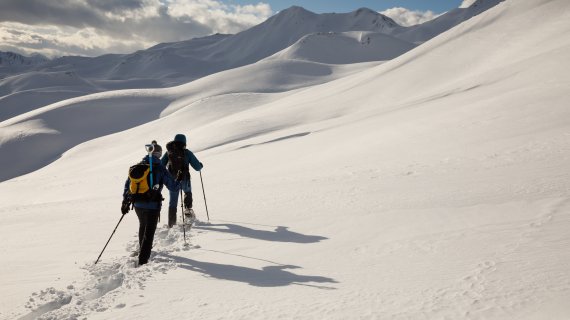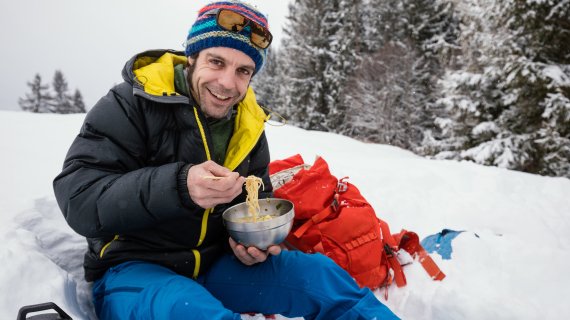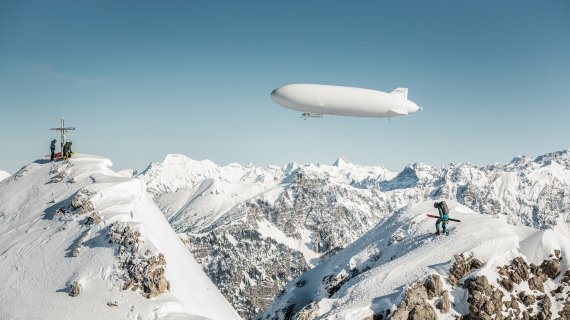On your own into untracked mountains: during a touring week in the Georgian Caucasus not only freeride pros will find slopes that are ready for shooting movies - especially for more modest offside skiers deep snow dreams come true on the mountain ranges of Svanetia
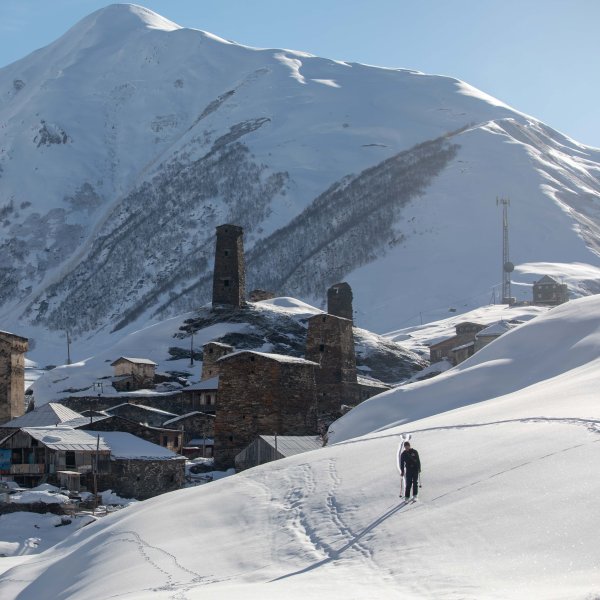
The wind-swept slope in the middle part of the mountain has held. The dip that follows is also no problem. After that there are three or four steep hairpin bends that we have to track into the finely patterned snow surface - into this calligraphy of regular wavy lines that the wind has painted overnight on the entire northern slopes of the Gvibari range. A lettering that we want so badly that it says to us, "Welcome, wanderer." And which, with a little experience of snow and storms, should actually be read as a clear warning: "Stop, or an avalanche will blow you down into the valley where you belong, little human!
But then we already reach the ridge through the cornice, which runs in east-west direction at an altitude of about 3000 meters. With a last step up, a view opens up that takes our gasping breath away. Below us 1000 meters of cold, pressed powder are waiting for our untamed descent. The horizon on the other side of the valley to the north is formed by the ice walls of the Shkhara, which is over 5000 meters high. In the south, the mountain ranges are staggered up to the plains toward the Black Sea. And if one would climb the ridge that we have just climbed one hour further to the east, one would reach abruptly dropping snow ridges, interspersed by couloirs and cliffs, so steep that one can barely ride the terrain.
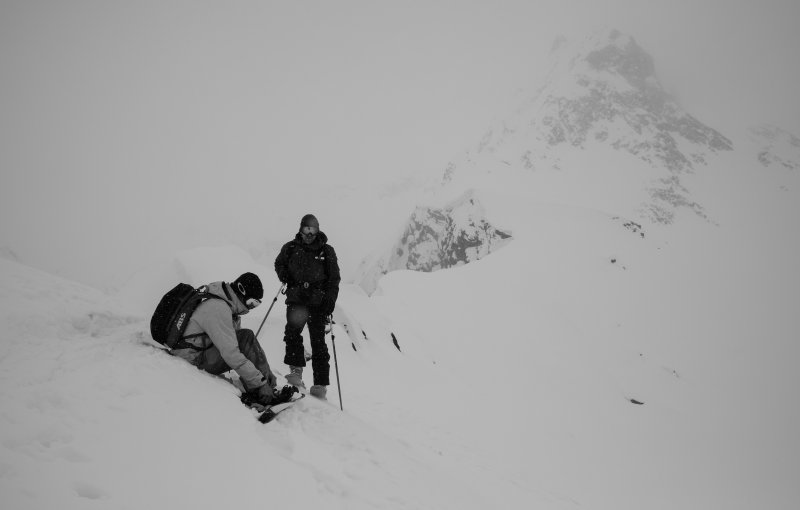
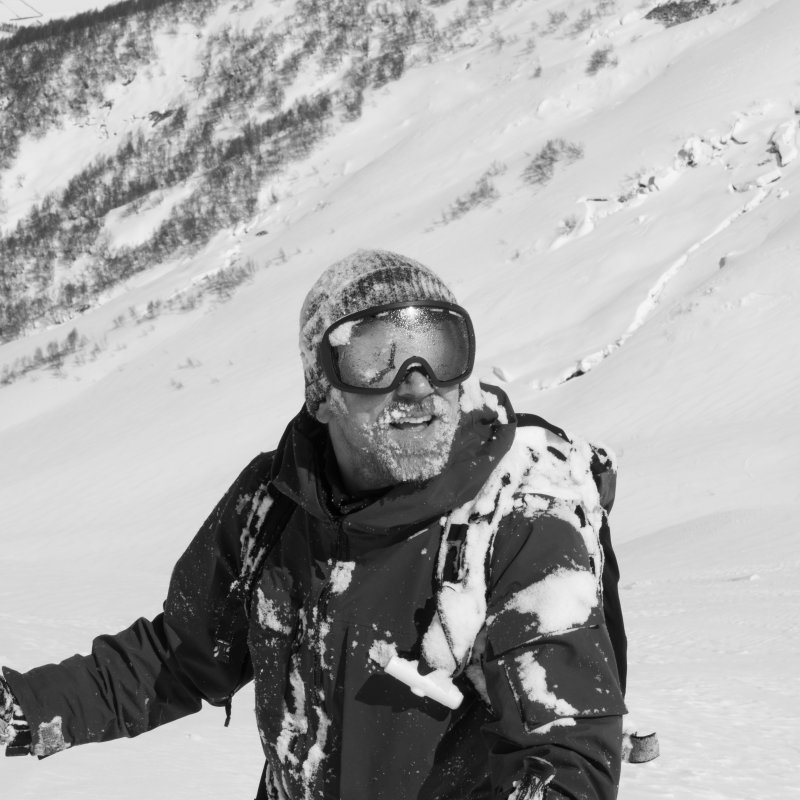
We have no idea if anyone has ever tried this before. But the potential that the Georgian High Caucasus offers skiers is confirmed when they see these incredible mountain ranges live for the first time. If we turn 360 degress up here, we see an endless camera pan from an Alaskan freeski movie - but somehow zoomed in at 200 percent. The peaks: more evil. The faces: longer. The area: wilder. Just like in the video we noticed early in last the winter with little snow: "Ushba" shows how a group around the Swiss extreme skier Samuel Anthamatten wants to ride the north face of Mount Ushba with the striking double peak in spring 2017. It's too icy for the descent. Instead, the freeskiers fly by helicopter to prviously unridden super steep slopes in the area, to race down in huge speedy turns. What a way to fail.
The great thing about a winter trip to Georgia: It is definitely worth it. No matter what the snow is like
Of course, we too dream of first descents and movie-worthy power-turns, but in the absence of helicopters and professional freeride skills, we want to try more relaxed ski tours. Nevertheless our little expedition to Georgia feels like an adventure. From the capital Tbilisi, a night train, which could have been the result of a Wes Anderson remake shot on a very low budget, takes you across the plain to the west. A jerky mini-bus ride leads through snow-free forest valleys further into the high mountains. Detailed map material? Is currently being prepared for tourist use. Mountain rescue? You have to take care of it yourself. We have a few map sections from friends who were here last year on our phone. And an e-mail from Audun, a Norwegian who has been organizing ski tours in the area for a few years but is currently out of the country: Good conditions this year, he writes, lots of snow, stable snow cover and regular snowfall. We want to find out the rest on the spot - and as good as the communication with young Georgians in the valleys works out: the further we approach the very high mountains, the more complicated things get.
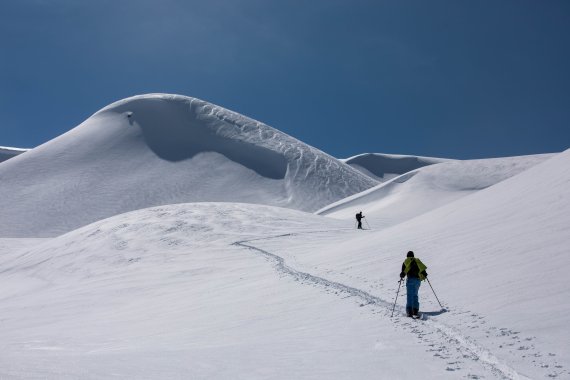
The great thing about a winter trip to Georgia: It is definitely worth it. It doesn't matter what the snow is like. The land on the edge of the Old World, which already appeared with the Greeks (the search for the Golden Fleece led the Argonauts to Colchis, on the slopes of the Caucasus), literally steams its rich history and culture. It is quite possible that viticulture was invented here thousands of years ago. The cuisine is so legendary that in the Soviet Union it was considered good manners to have a Georgian wife once you reached a certain elite status among all the equals - Georgian women were not only considered the best cooks, but also the most beautiful women in the whole empire. The Georgian man, on the other hand, is considered a relaxed shepherd, at least when it comes to a creation myth that Georgians like to tell about themselves and their homeland: When God created the world, He distributed it among the people. He kept the most beautiful spot for himself. Only one had slept through the distribution. He then got the small country that God had actually intended for himself - the first Georgian.
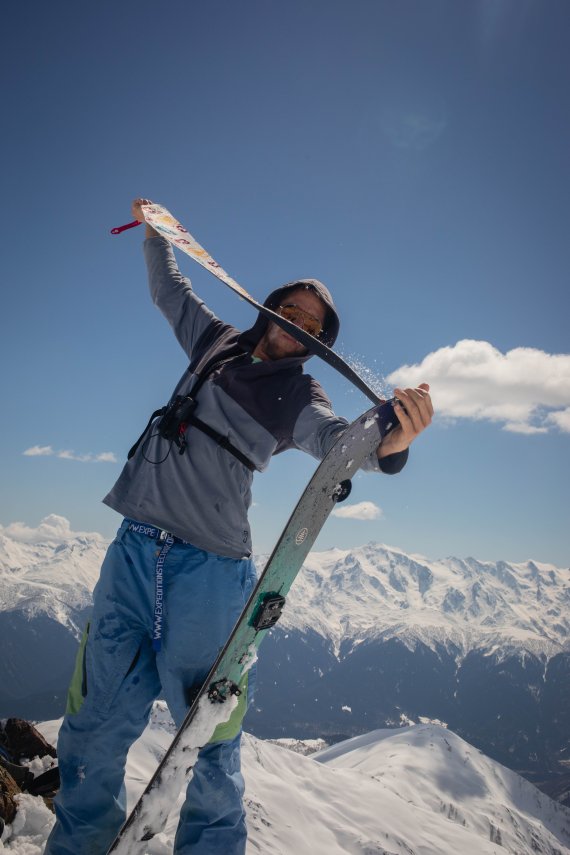
In fact, you can already guess it when you arrive in the mountains: Georgia is something like a mini-earth. Almost all landscapes that one can imagine are compressed into the space of Bavaria. From the palm trees of the Black Sea coast it is only 150 kilometres to the border ridge of the Great Caucasus, which separates the country from Russia as a 5000-metre high wall. And, of course, it is above all this wall that ensures that a winter trip to Georgia is very likely to be a success from a skiing point of view. The Caucasus is, not only for helicopter skiers, a winter wonderland. Although there are only a few ski resorts spread across the country. In the Lesser Caucasus there are two resorts with plenty of powder snow especially in the high winter and interesting powder runs, which are approached by snowcat. In the High Caucasus, Gudauri is located on the old Russian army road, quite easy to reach from the capital - with potential to climb even very high mountains. The jewel, however, is Svanetia: ascending mountain ranges, with narrow, hardly accessible valleys and the highest peaks of the country. In the summer now a trekking region that is becoming increasingly popular. In winter still: largely empty.
We play with the solar exposure, the slope inclination, the wind direction. Tendency: to step on the risk brake. A few days before our arrival a ski-tourer was buried here in Ushguli
"Throughout the season, the snowpack was stable," says Shako Margiani, in his mid-twenties, fit, slim, well equipped and informed - and in a pleasant way clear and at eye level when asked about his assessment of the current situation in Svanetia. We meet the young mountain guide in Mestia, the starting point for winter sports activities in Svanetia. "But last week it snowed with a lot of wind and there's more to come." He advises us to be careful, gives us a few more recommendations for day trips and wishes us good luck.
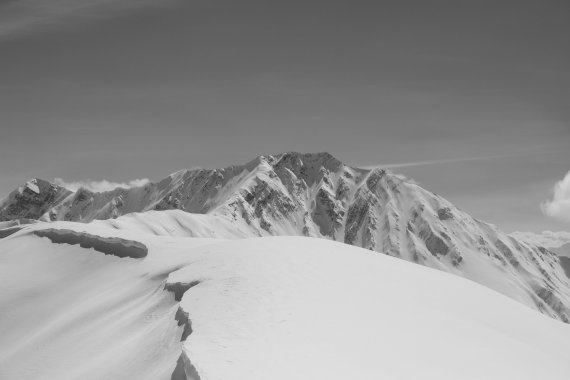
After all, the ski resort on the Tetnuldi seems to be still open - an information that could not be obtained with absolute certainty from outside the country. Apart from Gudauri, it is the only one in the Greater Caucasus - and on the day of our visit it is almost absurdly empty. Maybe it is due to the somewhat unconventional accessibility: in order to get to the valley(!) station, one first has to drive up the mountain by taxi for half an hour from the centre of Mestia, whose houses are lined up on both sides of the only larger street, as in a city from a western. This would be actually uncomplicated, as in the mornings, collective taxis are waiting and it is quite easy to form car pools. But those who let themselves be driven to one of the guest houses at the arrival in Mestia risk that the driver assumes that they have been booked as a kind of mixture of chauffeur and tour guide for the whole stay in the region. At least our first driver, who is the size of a brown bear, leaves little doubt that he firmly expects to count us among his customers again the next day. His already deep voice slides even further into his belly when, upon arrival at the parking lot of the absurd ski resort, he exchanges his thoughts with his colleagues in Svan. One of my brothers mumbles: "Be careful, he speaks the language of the orcs" There are three of us, but as a precaution we at least promise to return to Mestia with him.
A last view of the overwhelming world-class panorama. Then we take the undulating north descent from the Gvibari ridge
The first chairlift transports the visitor closer to the mountain rather than higher up. But from lift two on, it's suddenly steep uphill: over beautifully docked terrain interspersed with light forest, through which only a few, hardly used slopes wind. And finally up to over 3000 meters below the walls of Tetnuldi. The fresh snow of the last few days is lying perfectly thirty, forty centimeters high up here. After a few warm-up runs, we venture into a basin at the back of the ski area, which can be reached from a small summit structure in almost all directions through partly steep couloirs - and which doesn't look very safe due to the drifting snow. We spend a whole day enjoying ourselves and even have the opportunity to venture a little onto the flanks to the east, from where we can see the mountain ranges that have been the destination of our journey from the beginning: The touring area around the village of Ushguli, at the very end of the pass road which is open in winter.
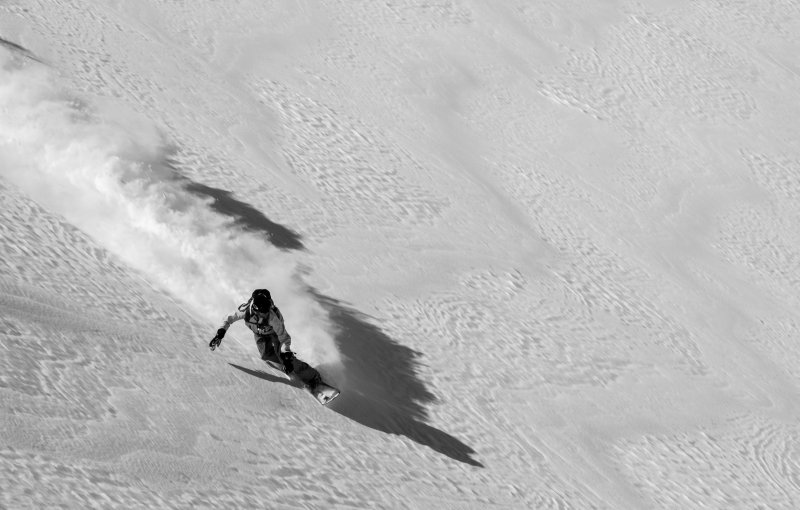
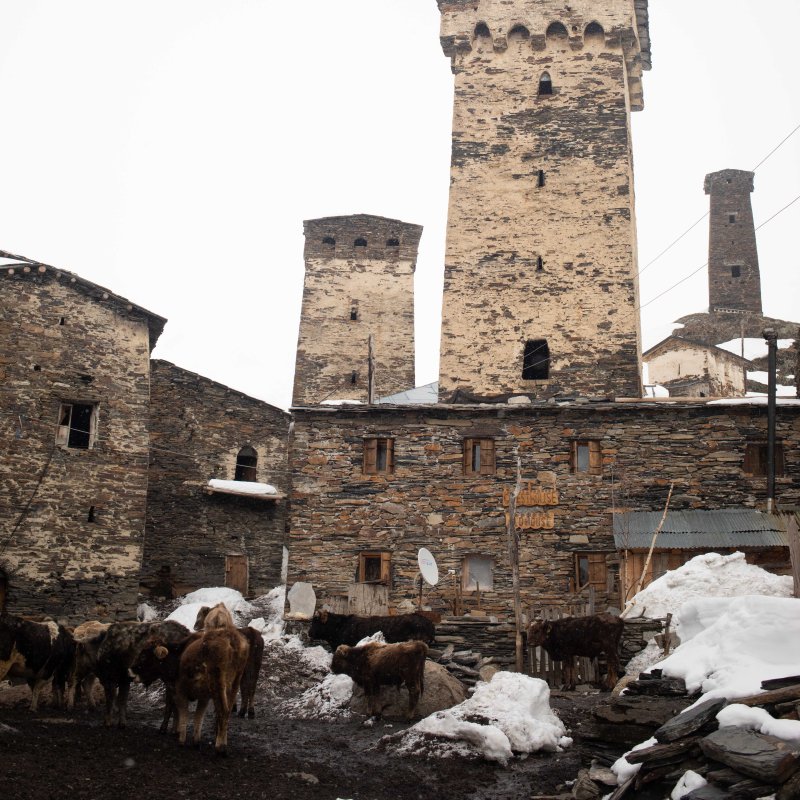
On day three of the trip, after two more hours of hair-raising driving in a not a bit underchallenged off-road vehicle, we get out of the car in Ushguli and drag our luggage over a wooden bridge to the oldest part of the settlement. We feel like we are entering a film set for a yet unreleased season of "Game of Thrones": Black towers with tiny embrasures stand in front of a pale winter sky. In the narrow alleys, a mixture of cow dung and slush makes every step a balancing act. At a barn door, a man of a difficult to guess age leans silently against us and looks at us without blinking. Cows and horses crowd between the walls. Pigs dig through the frozen mud with their snout. There are wolves patrolling the walls. Not true. They're Caucasian shepherd dogs. They're too big for wolves.
Ushguli, with its 12th century fortified towers, is a World Heritage Site - despite the towers' dark history, which recalls a tradition that no one wants to see returned to the present.
Ushguli, with its 12th century fortified towers, is a World Heritage Site - despite the towers' dark history, which recalls a tradition that no one wants to see returned to the present. In fact, they served less as a refuge from invading gangs of robbers - but rather from the dear neighbors who lurked at the front door for reasons of blood revenge; often based on bagatelles, sometimes for months, even years. Whole families are said to have barricaded themselves in the towers until a deal was found or, alternatively, another relative was shot. But we do not want to create a false impression: To us travellers, the Georgians and especially the Svanians are an extremely warm, almost shamefully hospitable people. When we want to chat with a family in Mestia about their living conditions, we are welcomed with a small feast in the middle of the afternoon, homemade wine, fruit, pastries. And the lady of the housey, who runs a guesthouse here in Ushguli, which is somewhat exaggerated called a "hotel", serves us up food every evening as if we were heading into the all-decisive battle against the Russians the next day. There is little more satisfying after a day on the mountain than a freshly baked Kubdari, the Svan version of the homemade stuffed bread, which is filled with cheese everywhere else in Georgia as Khachapuri, but here with garlic, cumin, coriander and fennel seed seasoned meat.
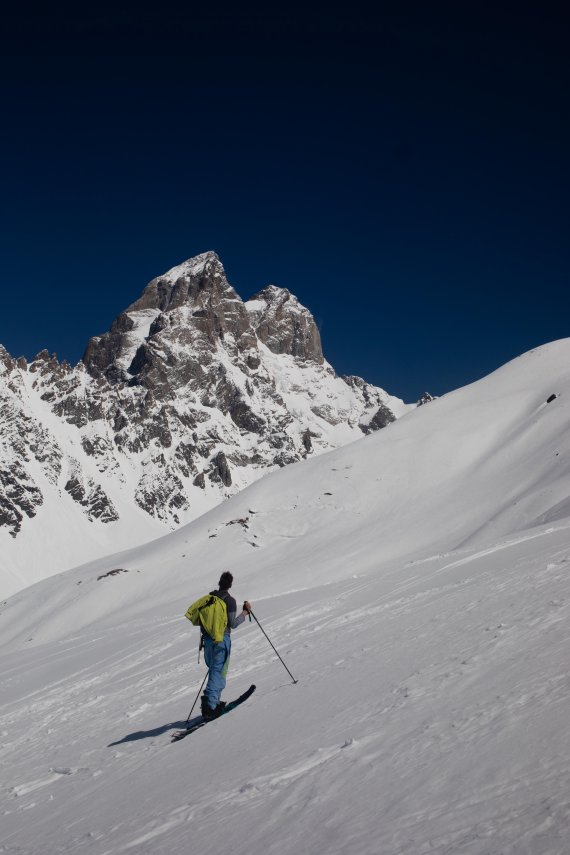
The tour area in front of the medieval towers can be scaled as required. While on the day of our arrival it is still cloudy and hazy, already the next day the first holes in the clouds can be seen, before the blue skies break finally through completey. We play with the solar exposure, the slope inclination, the wind direction. Tendency: step on the risk brake. A few days before our arrival, a ski-tourer was buried here in Ushguli. Phew! Shako, the mountain guide from Mestia, has advised us against any kind of Alaska lines, at least for this week, also and especially because movie-ready terrain is quite easy to reach without any ascent aids here. On our rudimentary mobile phone map we even had arranged a perfect multi-day tour, with overnight stays in even smaller hamlets than Ushguli, where only one or two families stay in winter. But it shall not be the last time that we travel to the most beautiful country in the world. In winter, of course.
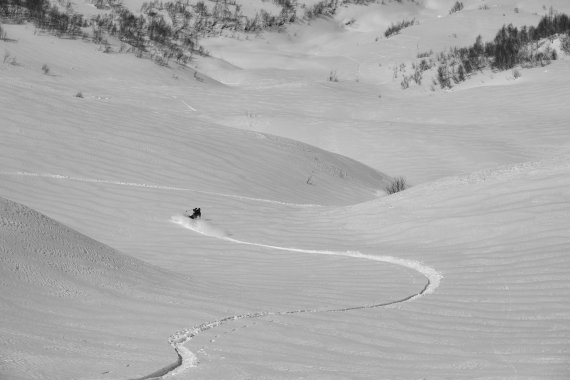
A last view of the overwhelming world-class panorama. Then we take the waved north descent from the Gvibari ridge. We check our avalanche beacons and ride the first slope quickly and loose in the legs to the edge, behind which it gets a little steeper. From the top you can easily spot the rideable lines, we try to avoid the steepest parts today. There are indeed a few wind slabs on the surface, but all in all the conditions feel manageable. The snow is really fast, and although we stick to the medium steep terrain, the descent is so good that we decide to climb up again halfway up.
Maybe we'll manage to eat the Svanian dinner for the first time today.

